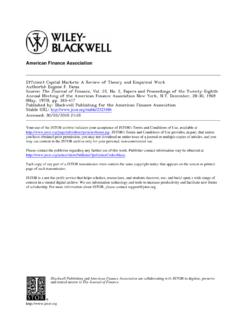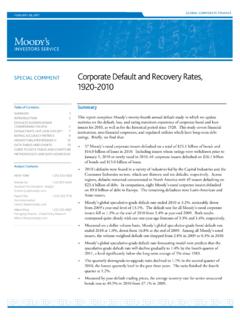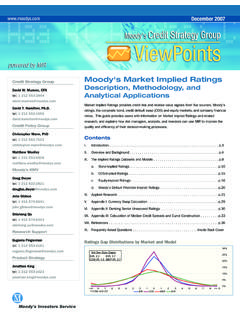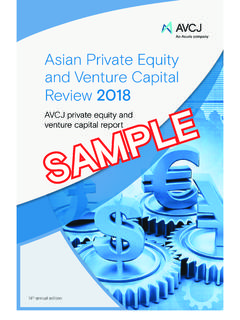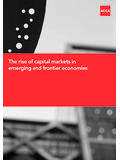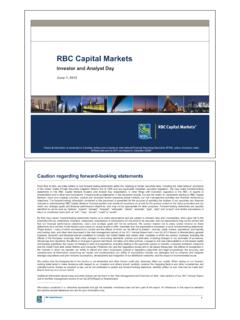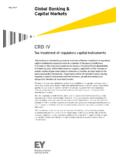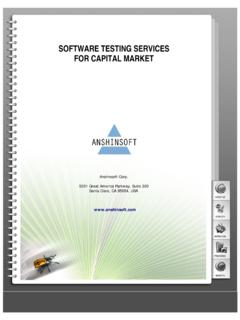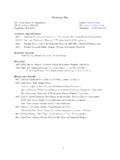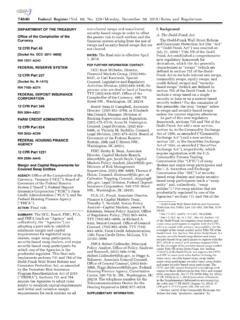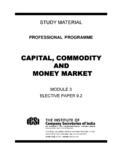Transcription of American Finance Association
1 American Finance AssociationEfficient capital Markets: IIAuthor(s): Eugene F. FamaSource: The Journal of Finance , Vol. 46, No. 5 (Dec., 1991), pp. 1575-1617 Published by: Blackwell Publishing for the American Finance AssociationStable URL: : 30/03/2010 21:19 Your use of the JSTOR archive indicates your acceptance of JSTOR's Terms and Conditions of Use, available JSTOR's Terms and Conditions of Use provides, in part, that unlessyou have obtained prior permission, you may not download an entire issue of a journal or multiple copies of articles, and youmay use content in the JSTOR archive only for your personal, non-commercial contact the publisher regarding any further use of this work. Publisher contact information may be obtained copy of any part of a JSTOR transmission must contain the same copyright notice that appears on the screen or printedpage of such is a not-for-profit service that helps scholars, researchers, and students discover, use, and build upon a wide range ofcontent in a trusted digital archive.
2 We use information technology and tools to increase productivity and facilitate new formsof scholarship. For more information about JSTOR, please contact Publishing and American Finance Association are collaborating with JSTOR to digitize, preserveand extend access to The Journal of JOURNAL OF Finance * VOL. XLVI, NO. 5 * DECEMBER 1991 Efficient capital Markets: II EUGENE F. FAMA* SEQUELS ARE RARELY AS good as the originals, so I approach this review of the market efflciency literature with trepidation. The task is thornier than it was 20 years ago, when work on efficiency was rather new. The literature is now so large that a full review is impossible, and is not attempted here. Instead, I discuss the work that I find most interesting, and I offer my views on what we have learned from the research on market efficiency. I. The Theme I take the market efficiency hypothesis to be the simple statement that security prices fully reflect all available information.
3 A precondition for this strong version of the hypothesis is that information and trading costs, the costs of getting prices to reflect information, are always 0 (Grossman and Stiglitz (1980)). A weaker and economically more sensible version of the efficiency hypothesis says that prices reflect information to the point where the marginal benefits of acting on information (the profits to be made) do not exceed the marginal costs (Jensen (1978)). Since there are surely positive information and trading costs, the extreme version of the market efficiency hypothesis is surely false. Its advantage, however, is that it is a clean benchmark that allows me to sidestep the messy problem of deciding what are reasonable information and trading costs. I can focus instead on the more interesting task of laying out the evidence on the adjustment of prices to various kinds of information. Each reader is then free to judge the scenarios where market efficiency is a good approximation (that is, deviations from the extreme version of the efficiency hypothesis are within information and trading costs) and those where some other model is a better simplifying view of the world.
4 Ambiguity about information and trading costs is not, however, the main obstacle to inferences about market efficiency. The joint-hypothesis problem is more serious. Thus, market efficiency per se is not testable. It must be * Graduate School of Business, University of Chicago. The comments of Fischer Black, David Booth, Michael Bradley, Michael Brennan, Stephen Buser, John Campbell, Nai-fu Chen, John Cochrane, George Constantinides, Wayne Ferson, Kenneth French, Campbell Harvey, Richard Ippolito, Michael Jensen, Gautam Kaul, Josef Lakonishok, Bill McDonald, Robert Merton, Mark Mitchell, Sam Peltzman, Marc Reinganum, Jay Ritter, Harry Roberts, Richard Roll, G. William Schwert, H. Nejat Seyhun, Jay Shanken, Robert Shiller, Andrei Shleifer, Rex Sinquefield, Rene Stulz, Richard Thaler, Robert Vishny, and Jerold Warner are gratefully acknowledged. This research is supported by the National Science Foundation. 1575 1576 The Journal of Finance tested jointly with some model of equilibrium, an asset-pricing model.
5 This point, the theme of the 1970 review (Fama (1970b)), says that we can only test whether information is properly reflected in prices in the context of a pricing model that defines the meaning of "properly." As a result, when we find anomalous evidence on the behavior of returns, the way it should be split between market inefficiency or a bad model of market equilibrium is ambiguous. Does the fact that market efficiency must be tested jointly with an equilib- rium-pricing model make empirical research on efficiency uninteresting? Does the joint-hypothesis problem make empirical work on asset-pricing models uninteresting? These are, after all, symmetric questions, with the same answer. My answer is an unequivocal no. The empirical literature on efficiency and asset-pricing models passes the acid test of scientific useful- ness. It has changed our views about the behavior of returns, across securi- ties and through time. Indeed, academics largely agree on the facts that emerge from the tests, even when they disagree about their implications for efficiency.
6 The empirical work on market efficiency and asset-pricing models has also changed the views and practices of market professionals. As these summary judgements imply, my view, and the theme of this paper, is that the market efficiency literature should be judged on how it improves our ability to describe the time-series and cross-section behav- ior of security returns. It is a disappointing fact that, because of the joint- hypothesis problem, precise inferences about the degree of market efficiency are likely to remain impossible. Nevertheless, judged on how it has improved our understanding of the behavior of security returns, the past research on market efficiency is among the most successful in empirical economics, with good prospects to remain so in the future. II. The Main Areas of Research The 1970 review divides work on market efficiency into three categories: (1) weak-form tests (How well do past returns predict future returns?), (2) semi-strong-form tests (How quickly do security prices reflect public informa- tion announcements?)
7 , and (3) strong-form tests (Do any investors have private information that is not fully reflected in market prices?) At the risk of damning a good thing, I change the categories in this paper. Instead of weak-form tests, which are only concerned with the forecast power of past returns, the first category now covers the more general area of tests for return predictability, which also includes the burgeoning work on forecasting returns with variables like dividend yields and interest rates. Since market efficiency and equilibrium-pricing issues are inseparable, the discussion of predictability also considers the cross-sectional predictability of returns, that is, tests of asset-pricing models and the anomalies (like the size effect) discovered in the tests. Finally, the evidence that there are seasonals in returns (like the January effect), and the claim that security prices are too Efficient capital Markets: II 1577 volatile are also considered, but only briefly, under the rubric of return predictability.
8 For the second and third categories, I propose changes in title, not cover- age. Instead of semi-strong-form tests of the adjustment of prices to public announcements, I use the now common title, event studies. Instead of strong- form tests of whether specific investors have information not in market prices, I suggest the more descriptive title, tests for private information. Return predictability is considered first, and in the most detail. The detail reflects my interest and the fact that the implications of the evidence on the predictability of returns through time are the most controversial. In brief, the new work says that returns are predictable from past returns, dividend yields, and various term-structure variables. The new tests thus reject the old market efficiency-constant expected returns model that seemed to do well in the early work. This means, however, that the new results run head-on into the joint-hypothesis problem: Does return predictability reflect rational vari- ation through time in expected returns, irrational deviations of price from fundamental value, or some combination of the two?
9 We should also acknowl- edge that the apparent predictability of returns may be spurious, the result of data-dredging and chance sample-specific conditions. The evidence discussed below, that the variation through time in expected returns is common to corporate bonds and stocks and is related in plausible ways to business conditions, leans me toward the conclusion that it is real and rational. Rationality is not established by the existing tests, however, and the joint-hypothesis problem likely means that it cannot be established. Still, even if we disagree on the market efficiency implications of the new results on return predictability, I think we can agree that the tests enrich our knowledge of the behavior of returns, across securities and through time. Event studies are discussed next, but briefly. Detailed reviews of event studies are already available, and the implications of this research for market efficiency are less controversial. Event studies have, however, been a growth industry during the last 20 years.
10 Moreover, I argue that, because they come closest to allowing a break between market efficiency and equilib- rium-pricing issues, event studies give the most direct evidence on efficiency. And the evidence is mostly supportive. Finally, tests for private information are reviewed. The new results clarify earlier evidence that corporate insiders have private information that is not fully reflected in prices. The new evidence on whether professional invest- ment managers (mutual fund and pension fund) have private information is, however, murky, clouded by the joint-hypothesis problem. III. Return Predictability: Time-Varying Expected Returns There is a resurgence of research on the time-series predictability of stock returns, that is, the variation (rational or irrational) of expected returns through time. Unlike the pre-1970 work, which focused on forecasting re- turns from past returns, recent tests also consider the forecast power of 1578 The Journal of Finance variables like dividend yields (D/P), earnings/price ratios (E/P), and term- structure variables.
